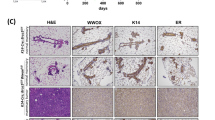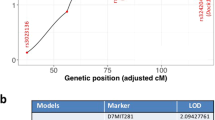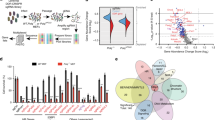Abstract
The DNA strand break-binding molecule, poly(ADP-ribose) polymerase-1 (PARP-1), plays a role in DNA repair, chromosomal stability, transcription and cell death. Accumulating evidence suggests that dysfunction of PARP-1 contributes to tumorigenesis. Here, we report that PARP-1 deficiency causes mammary carcinoma formation in female mice, and that the introduction of Trp53 mutations accelerates the onset and shortens the latency of mammary tumorigenesis. We show that PARP-1 deficiency results in chromosomal aneuploidy and centrosome amplification, which are substantiated by the inactivation of Trp53 in primary mammary epithelial (PME) cells. In addition, PARP-1 deficiency compromises p53 activation and impairs BRCA1 recruitment to the sites of DNA damage in PME cells. PARP-1 complementation partly rescues the defective DNA damage response mediated by p53 and BRCA1. The present study thus identifies a role of PARP-1 in suppressing mammary tumorigenesis in vivo and suggests that dysfunction of PARP-1 may be a risk factor for breast cancer in humans.
This is a preview of subscription content, access via your institution
Access options
Subscribe to this journal
Receive 50 print issues and online access
$259.00 per year
only $5.18 per issue
Buy this article
- Purchase on Springer Link
- Instant access to full article PDF
Prices may be subject to local taxes which are calculated during checkout






Similar content being viewed by others
References
Ame JC, Spenlehauer C, de Murcia G . (2004). The PARP superfamily. Bioessays 26: 882–893.
Bell DW, Varley JM, Szydlo TE, Kang DH, Wahrer DCR, Shannon KE et al. (1999). Heterozygous germ line hCHK2 mutations in Li-Fraumeni syndrome. Science 286: 2528–2531.
Beneke R, Moroy T . (2001). Inhibition of poly(ADP-ribose) polymerase activity accelerates T-cell lymphomagenesis in p53 deficient mice. Oncogene 20: 8136–8141.
Bieche I, de Murcia G, Lidereau R . (1996). Poly(ADP-ribose) polymerase gene expression status and genomic instability in human breast cancer. Clin Cancer Res 2: 1163–1167.
Bryant HE, Schultz N, Thomas HD, Parker KM, Flower D, Lopez E et al. (2005). Specific killing of BRCA2-deficient tumours with inhibitors of poly(ADP-ribose) polymerase. Nature 434: 913–917.
Cardiff RD, Anver MR, Gusterson BA, Hennighausen L, Jensen RA, Merino MJ et al. (2000). The mammary pathology of genetically engineered mice: the consensus report and recommendations from the Annapolis meeting. Oncogene 19: 968–988.
Chao C, Saito S, Anderson CW, Appella E, Xu Y . (2000). Phosphorylation of murine p53 at ser-18 regulates the p53 responses to DNA damage. Proc Natl Acad Sci USA 97: 11936–11941.
Cortez D, Wang Y, Qin J, Elledge SJ . (1999). Requirement of ATM-dependent phosphorylation of brca1 in the DNA damage response to double-strand breaks. Science 286: 1162–1166.
Cressman VL, Backlund DC, Hicks EM, Gowen LC, Godfrey V, Koller BH . (1999). Mammary tumor formation in p53- and BRCA1-deficient mice. Cell Growth Differ 10: 1–10.
Crook T, Crossland S, Crompton MR, Osin P, Gusterson BA . (1997). p53 mutations in BRCA1-associated familial breast cancer. Lancet 350: 638–639.
De Soto JA, Deng CX . (2006). PARP-1 inhibitors: are they the long-sought genetically specific drugs for BRCA1/2-associated breast cancers? Int J Med Sci 3: 117–123.
De Soto JA, Wang X, Tominaga Y, Wang RH, Cao L, Skoumbourdis AP et al. (2006). The inhibition and treatment of breast cancer with poly (ADP-ribose) polymerase (PARP-1) inhibitors. Int J Biol Sci 2: 179–185.
Deng CX . (2002). Role of BRCA1 in centrosome duplication. Oncogene 21: 6222–6227.
Donehower LA, Harvey M, Slagle BL, McArthur MJ, Montgomery Jr CA, Butel JS et al. (1992). Mice deficient for p53 are developmentally normal but susceptible to spontaneous tumours. Nature 356: 215–221.
Edwards PAW, Abram CL, Bradbury JM . (1996). Genetic manipulation of mammary epithelial by transplantation. J Mamm Gland Biol Neoplasia 1: 75–89.
Farmer H, McCabe N, Lord CJ, Tutt AN, Johnson DA, Richardson TB et al. (2005). Targeting the DNA repair defect in BRCA mutant cells as a therapeutic strategy. Nature 434: 917–921.
Hanahan D, Weinberg RA . (2000). The hallmarks of cancer. Cell 100: 57–70.
Hao B, Wang H, Zhou K, Li Y, Chen X, Zhou G et al. (2004). Identification of genetic variants in base excision repair pathway and their associations with risk of esophageal squamous cell carcinoma. Cancer Res 64: 4378–4384.
Helleday T, Bryant HE, Schultz N . (2005). Poly(ADP-ribose) polymerase (PARP-1) in homologous recombination and as a target for cancer therapy. Cell Cycle 4: 1176–1178.
Herceg Z, Wang ZQ . (1999). Failure of poly(ADP-ribose) polymerase cleavage by caspases leads to induction of necrosis and enhanced apoptosis. Mol Cell Biol 19: 5124–5133.
Hu JJ, Roush GC, Dubin N, Berwick M, Roses DF, Harris MN . (1997). Poly(ADP-ribose) polymerase in human breast cancer: a case-control analysis. Pharmacogenetics 7: 309–316.
Jonkers J, Meuwissen R, van der Gulden H, Peterse H, van der Valk M, Berns A . (2001). Synergistic tumor suppressor activity of BRCA2 and p53 in a conditional mouse model for breast cancer. Nat Genet 29: 418–425.
Kanai M, Tong WM, Sugihara E, Wang ZQ, Fukasawa K, Miwa M . (2003). Involvement of poly(ADP-ribose) polymerase-1 and poly(ADP-ribosyl)ation in regulation of centrosome function. Mol Cell Biol 23: 2451–2462.
Kim MY, Zhang T, Kraus WL . (2005). Poly(ADP-ribosyl)ation by PARP-1: ‘PAR-laying’ NAD+ into a nuclear signal. Genes Dev 19: 1951–1967.
Lebel M, Lavoie J, Gaudreault I, Bronsard M, Drouin R . (2003). Genetic cooperation between the Werner syndrome protein and poly(ADP-ribose) polymerase-1 in preventing chromatid breaks, complex chromosomal rearrangements, and cancer in mice. Am J Pathol 162: 1559–1569.
Li S, Ting NS, Zheng L, Chen PL, Ziv Y, Shiloh Y et al. (2000). Functional link of BRCA1 and ataxia telangiectasia gene product in DNA damage response. Nature 406: 210–215.
Lockett KL, Hall MC, Xu J, Zheng SL, Berwick M, Chuang SC et al. (2004). The ADPRT V762A genetic variant contributes to prostate cancer susceptibility and deficient enzyme function. Cancer Res 64: 6344–6348.
Ludwig T, Fisher P, Murty V, Efstratiadis A . (2001). Development of mammary adenocarcinomas by tissue-specific knockout of Brca2 in mice. Oncogene 20: 3937–3948.
Malkin D . (1998). In: Volgestein B, Kinzler KW (eds). The Li-Fraumeni Syndrome: The Genetic Basis of Human Cancer. McGraw-Hill: New York, pp 393–407.
Masutani M, Nakagama H, Sugimura T . (2003). Poly(ADP-ribose) and carcinogenesis. Genes Chromosomes Cancer 38: 339–348.
McCabe N, Lord CJ, Tutt AN, Martin NM, Smith GC, Ashworth A . (2005). BRCA2-deficient CAPAN-1 cells are extremely sensitive to the inhibition of poly (ADP-Ribose) polymerase: an issue of potency. Cancer Biol Ther 4: 934–936.
Morrison C, Smith GC, Stingl L, Jackson SP, Wagner EF, Wang ZQ . (1997). Genetic interaction between PARP and DNA-PK in V(D)J recombination and tumorigenesis. Nat Genet 17: 479–482.
Nozaki T, Fujihara H, Watanabe M, Tsutsumi M, Nakamoto K, Kusuoka O et al. (2003). Parp-1 deficiency implicated in colon and liver tumorigenesis induced by azoxymethane. Cancer Sci 94: 497–500.
Paull TT, Rogakou EP, Yamazaki V, Kirchgessner CU, Gellert M, Bonner WM . (2000). A critical role for histone H2Ax in recruitment of repair factors to nuclear foci after DNA damage. Curr Biol 10: 886–895.
Rajaee-Behbahani N, Schmezer P, Ramroth H, Burkle A, Bartsch H, Dietz A et al. (2002). Reduced poly(ADP-ribosyl)ation in lymphocytes of laryngeal cancer patients: results of a case–control study. Int J Cancer 98: 780–784.
Shibata A, Kamada N, Masumura K, Nohmi T, Kobayashi S, Teraoka H et al. (2005). Parp-1 deficiency causes an increase of deletion mutations and insertions/rearrangements in vivo after treatment with an alkylating agent. Oncogene 24: 1328–13237.
Shiokawa M, Masutani M, Fujihara H, Ueki K, Nishikawa R, Sugimura T et al. (2005). Genetic alteration of poly(ADP-ribose) polymerase-1 in human germ cell tumors. Jpn J Clin Oncol 35: 97–102.
Stewart BW, Kleihues P (ed). (2003). Breast Cancer: World Cancer Report. IARC Press: Lyon.
Tong WM, Cortes U, Hande MP, Ohgaki H, Cavalli LR, Lansdorp PM et al. (2002). Synergistic role of Ku80 and poly(ADP-ribose) polymerase in suppressing chromosomal aberrations and liver cancer formation. Cancer Res 62: 6990–6996.
Tong WM, Cortes U, Wang ZQ . (2001a). Poly(ADP-ribose) polymerase: a guardian angel protecting genome and suppressing tumorigenesis. Biochim Biophys Acta-Rev on Cancer 1552: 27–37.
Tong WM, Hande MP, Lansdorp PM, Wang ZQ . (2001b). DNA-strand break-sensing molecule PARP cooperates with p53 in telomere function, chromosomal stability and tumor suppression. Mol Cell Biol 21: 4046–4054.
Tong WM, Ohgaki H, Huang H, Granier C, Kleihues P, Wang ZQ . (2003). Null mutation of DNA strand break-binding molecule poly(ADP-ribose) polymerase causes medulloblastomas in p53−/− mice. Am J Pathol 162: 343–352.
Tsutsumi M, Masutani M, Nozaki T, Kusuoka O, Tsujiuchi T, Nakagama H et al. (2001). Increased susceptibility of poly(ADP-ribose) polymerase-1 knockout mice to nitrosamine carcinogenicity. Carcinogenesis 22: 1–3.
Turner JM, Aprelikova O, Xu X, Wang R, Kim S, Chandramouli GV et al. (2004). BRCA1, histone H2AX phosphorylation, and male meiotic sex chromosome inactivation. Curr Biol 14: 2135–2142.
Venkitaraman AR . (2002). Cancer susceptibility and the functions of BRCA1 and BRCA2. Cell 108: 171–182.
Wang ZQ, Auer B, Stingl L, Berghammer H, Haidacher D, Schweiger M et al. (1995). Mice lacking ADPRT and poly(ADP-ribosyl)ation develop normally but are susceptible to skin disease. Genes Dev 9: 509–520.
Xu X, Wagner KU, Larson D, Weaver Z, Li C, Ried T et al. (1999). Conditional mutation of Brca1 in mammary epithelial cells results in blunted ductal morphogenesis and tumour formation. Nat Genet 22: 37–43.
Zhang X, Miao X, Liang G, Hao B, Wang Y, Tan W et al. (2005). Polymorphisms in DNA base excision repair genes ADPRT and XRCC1 and risk of lung cancer. Cancer Res 65: 722–726.
Acknowledgements
We thank C Granier, L Haddad, YG Xi, A Sadi, C Carreira and N Lyandrat for technical assistance. We are also grateful to Dr CX Deng for BRCA1 antibody (BRCA1-1059). Further thanks are due to Drs G Lenoir, J Hall and B Sedgwick for comments and to J Daniel for editing the manuscript. WM Tong was supported in part by grants from the Comité départemental de la Loire and de la Drôme, la Ligue Nationale Contre le Cancer, France. ZQ Wang was supported by Association pour la Recherche sur le Cancer, France. WH Cao is a predoctoral fellow supported by the International Agency for Research on Cancer (IARC), France.
Author information
Authors and Affiliations
Corresponding author
Additional information
Supplementary Information accompanies the paper on the Oncogene website (http://www.nature.com/onc).
Supplementary information
Rights and permissions
About this article
Cite this article
Tong, W., Yang, Y., Cao, W. et al. Poly(ADP-ribose) polymerase-1 plays a role in suppressing mammary tumourigenesis in mice. Oncogene 26, 3857–3867 (2007). https://doi.org/10.1038/sj.onc.1210156
Received:
Revised:
Accepted:
Published:
Issue Date:
DOI: https://doi.org/10.1038/sj.onc.1210156
Keywords
This article is cited by
-
Linking DNA repair and cell cycle progression through serine ADP-ribosylation of histones
Nature Communications (2022)
-
Long-term treatment with the PARP inhibitor niraparib does not increase the mutation load in cell line models and tumour xenografts
British Journal of Cancer (2018)
-
Mustard gas surrogate, 2-chloroethyl ethylsulfide (2-CEES), induces centrosome amplification and aneuploidy in human and mouse cells
Cell Biology and Toxicology (2014)
-
Let's huddle to prevent a muddle: centrosome declustering as an attractive anticancer strategy
Cell Death & Differentiation (2012)
-
The role of PARP1 in the DNA damage response and its application in tumor therapy
Frontiers of Medicine (2012)



